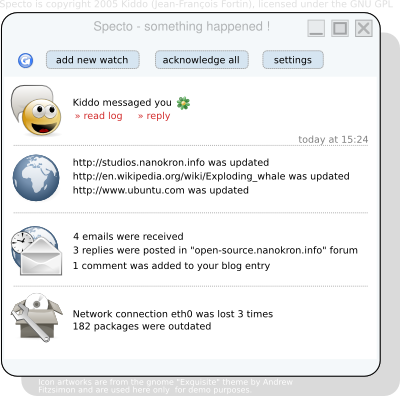In 2005, I had a crazy idea upon which I started the Specto project. Initially, I thought I’d call my revolutionary piece of software WhileYouWereOut (continuing the world’s tradition of ill-chosen project names), because it really was about solving a core “want” in my life: to leave my computer alone and catch up with events when I’d come back in front of it.
The core feature was to watch webpages for updates: back then, I did not know about syndication feeds, and I was sick of refreshing ifolder.com every single day hoping for a release of the peer-to-peer version of iFolder (for which we still have no equivalent today).
But why stop there? Why not handle events such as new emails, network failures (in those days, I ran my web server on my flaky residential connexion), software updates becoming available, and so on? You can grasp the whole genius of the idea by looking at one of the first mockups I drew back then:

Some old-timers among you may have noticed a ressemblance with Beagle‘s old user interface — back when it was called “Bleeding-Edge Search Tool”. Aaah, another nostalgic memory of the Novell desktop days.
Specto taught me that even if you have an arguably brilliant concept/mockup, random strangers on the Internet won’t magically jump onto your bandwagon and write code for you. Once this “reality check” finally set in after a couple of months, I took the dive and taught myself Python programming. Specto holds some sentimental value as it was my first OOP learning platform, but I’d probably be horrified if I were to look at its code now, after having considerably improved my skills by contributing to Pitivi. How the hell can Specto have nearly as much code as the current Pitivi development version, anyway!?
But I disgress. Where was I? Ah yes.
GNOME 3.6 made it all obsolete — finally.

The thought struck me recently: the user experience provided by GNOME Shell’s notification system is exactly what I needed all along. It fills my desire to have my computer patiently wait — like a tireless companion — for my return, without worrying about missing events.
If someone had shown me GNOME 3.6 in 2005, I would not have believed it. And yet, with the gradual changes in the 3.x series, we sometimes forget how fantastic the whole thing is.
Even with my heightened expectations, I was still impressed to see that I could now pick up calls even if my home desktop computer’s screen is locked! A real technological delight.
For watching the Web, Specto is now mostly irrelevant: Liferea is the program that took its place in my life. Arguably, social networks have also filled that role for many people.
Sometimes, the software you created becomes irrelevant and you find that to be a good thing.
Following up on my previous announcements where I called for a new maintainer and subsequently decided I wouldn’t touch anything without a patch, I can now say this in light of GNOME 3.6: Specto is dead. I don’t care about it anymore. Of course, if someone wants to take over maintainership/direction of the project, I’ll gladly give that ability to you.
Comments
One response to “A program's obsolescence”
I enjoyed the article. So true.